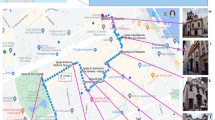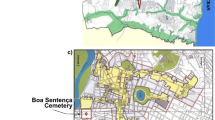Abstract
Cemeteries give evidence for a continuous change in sepulchral culture and provide insights into the application of characteristical rock materials used for tombstones during different times. Four selected cemeteries in Dresden (the Eliasfriedhof/Elias Cemetery, the Trinitatisfriedhof/Trinity Cemetery, the Johannisfriedhof/Johannis Cemetery, and the Städtischer Urnenhain/Municipal Urn Grove), which are of considerable cultural and historical importance, have been investigated within an ongoing mapping project. First results of this project focussing on the tombstone inventory of the mentioned graveyards and thus the use of building and decoration stones therein between 1680 and 1945 are presented in this paper. It can be demonstrated that the choice, variety, and application of rock material depends on the infrastructure and transport possibilities, but is also strongly influenced by sepulchral cultural trends and the prevailing zeitgeist. Until the middle of the 19th century, nearly solely Elbe sandstone (from the area of the Elbsandsteingebirge/Elbe sandstone mountains), that was transported on the Elbe river by ship, is found as rock material for tombstones in Dresden cemeteries. Rapid construction and development of the railway network starting around 1840 improved the availability, at first, of regional rock material (e.g., from the Lausitz/Lusatia) and, later on, from about 1880, of national and international—especially European—rock material (e.g., from Franken/Franconia, France, Scandinavia). Furthermore, the Friedhofsreformbewegung/cemetery reform movement at the beginning of the 20th century, with its significant effect on the selection of rock types used for tombstones, marks another historical breakthrough.









Similar content being viewed by others
References
Börner J (ed) (2011) 100 Jahre Krematorium und Urnenhain Dresden-Tolkewitz. Unter den Flügeln des Phönix. Sax, Markkleeberg, pp 1–224
Börner J, Heinz F, Kaden M, Lange J-M (2011) Grabmalgesteine. Städtischer Urnenhain Dresden-Tolkewitz. Miniaturen zur Geologie Sachsens GeoKommunen 3:1–64
Drinker H-S (1893) Tunneling, explosive compounds, and rock drill. Also, descriptions of the European and American systems, with tables giving the dimensions, cost, and leading data relating to the construction of about two thousand tunnels, compiled from notes furnished by engineers and railroad companies in North and South America, Europe, India, Australia and New Zealand, comprising a review of tunneling from the reign of Ramesses II to the present time, 3rd edn. Wiley, New York, pp 1–1143
Fettes D, Desmons J (eds) (2011) Metamorphic rocks. A classification and glossary of terms, new edn. Cambridge University Press, Cambridge, pp 1–258
Fischer N (1996) Vom Gottesacker zum Krematorium—Eine Sozialgeschichte der Friedhöfe in Deutschland seit dem 18. Jahrhundert, Hamburg, pp 1–315. http://ediss.sub.uni-hamburg.de. Accessed 15 March 2018
Fischer N (2002) Zwischen Kulturkritik und Funktionalität: Die Friedhofsreform und ihr gesellschaftlicher Kontext in Deutschland 1900–1930. In: Leisner B, Neumann W (eds) Vom Reichsausschuss zur Arbeitsgemeinschaft Friedhof und Denkmal. Kasseler Studien zur Sepulkralkultur, vol 9, pp 9–21
Fischer MH, Kaden M, Lange J-M, Mögel C, Richardt N, Stierand F (2013) Denkschrift “Unter den Flügeln des Phönix” zur Hundertjahrfeier von Krematorium und Urnenhain Dresden-Tolkewitz im Mai 2011. Blattwerk DD, Dresden, pp 1–40
Füchtbauer H (ed) (1988) Sedimente und Sedimentgesteine. Sediment-Petrologie, Teil II, 4th edn. Schweizerbart, Stuttgart, pp 1–1141
Grässel H (1913) Über Friedhofanlagen und Grabdenkmale. Dürerbund, Flugschrift zur Ausdruckskultur 60:1–31
Grimm W-D (2007) Gesteinsbestand und Verwitterung auf Friedhöfen des 19. Jahrhunderts, vor allem am Beispiel Münchens. ICOMOS, Hefte des Deutschen Nationalkomitees 44:153–169
Hallfahrt HG (1993) Berlin—Eisenbahn und Stadtentwicklung. Eisenbahn und Denkmalpflege. Zweites Symposium. ICOMOS, Hefte des Deutschen Nationalkomitees 9:48–59
Happe B (2007) Die Reform der Friedhofs- und Grabmalkultur zu Beginn des 20. Jahrhunderts—die Typisierung als reformästhetisches und soziales Gestaltungskonzept. ICOMOS, Hefte des Deutschen Nationalkomitees 44:24–34
Heinz F (2011) Grabmalgesteine im Spannungsfeld der Friedhofsreformbewegung. In: Börner J (ed) 100 Jahre Krematorium und Urnenhain Dresden-Tolkewitz. Unter den Flügeln des Phönix. Sax, Markkleeberg, pp 143–150
Heinz F, Kaden M, Lange J-M, Teichmann B (2009) Grabmalgesteine. Johannisfriedhof Dresden-Tolkewitz. Miniaturen zur Geologie Sachsens GeoKommunen 2:1–64
Heinz F, Kaden M, Lange J-M (2011a) Gesteinsanwendungen am Krematorium und auf dem Städtischen Urnenhain in Dresden-Tolkewitz. In: Börner J (ed) 100 Jahre Krematorium und Urnenhain Dresden-Tolkewitz. Unter den Flügeln des Phönix. Sax, Markkleeberg, pp 124–139
Heinz F, Kaden M, Lange J-M (2011b) Petrographie und Sepulkralkultur. Geologische und gesteinskundliche Betrachtungen auf dem Dresdner Urnenhain. In: Börner J (ed) 100 Jahre Krematorium und Urnenhain Dresden-Tolkewitz. Unter den Flügeln des Phönix. Sax, Markkleeberg, pp 122–150
Heinz F, Kaden M, Lange J-M, Fischer MH (2011c) “Von Rot-Meißen nach Schwarz-Schweden”—Gesteinskundliche Führungen über den Johannisfriedhof in Dresden-Tolkewitz. Ohlsdorf, Zeitschrift für Trauerkultur 113(2):5–9
Herrmann O (1899) Steinbruchindustrie und Steinbruchgeologie. Technische Geologie nebst praktischen Winken für die Verwertung von Gesteinen. Borntraeger, Berlin, pp 1–428
Hoyer EM (1995) Sächsischer Serpentin—ein Stein und seine Verwendung. Edition, Leipzig, pp 1–316
Hüttner J (1996) Der Fichtelgebirgsgranit. Werkstoff einer Region. Das Fichtelgebirge, Schriftenreihe zu seiner Geschichte. Natur Kultur 6:1–208
Lange J-M, Kaden M (2011) Zur Geologie des Städtischen Urnenhains in Dresden-Tolkewitz. In: Börner J (ed) 100 Jahre Krematorium und Urnenhain Dresden-Tolkewitz. Unter den Flügeln des Phönix. Sax, Markkleeberg, pp 122–123
Lange J-M, Kaden M, Heinz F (2011) Zöblitzer Serpentinit als Urnenmaterial—Eine Einführung in die Petrographie eines außergewöhnlichen Gesteins. In: Börner J (ed) 100 Jahre Krematorium und Urnenhain Dresden-Tolkewitz. Unter den Flügeln des Phönix. Sax, Markkleeberg, pp 140–142
Le Maitre RW (ed) (2008) Igneous rocks. A classification and glossary of terms, 2nd edn. Cambridge University Press, Cambridge, pp 1–256
Leisner B, Schulze HK, Thormann E, von Rauch A (1990) Der Hamburger Hauptfriedhof Ohlsdorf: Geschichte und Grabmäler, Band 1. Hamburg-Inventar Band 4. Hans Christians, Hamburg, pp 1–243
Memmesheimer PA (1968) Das klassizistische Grabmal—Eine Typologie, Thesis. Universität Bonn, Bonn, pp 1–384
Müller F, Kögler R (1977–2017) INSK. Internationale Natursteinkartei. Ebner, Ulm
Stein M (2000) Friedhöfe in Dresden. Verlag der Kunst, Dresden, pp 1–160
Weigelt H (2010) Von den Anfängen der Eisenbahn bis zur Glanzzeit deutscher Länderbahnen—ein Überblick. Eisenbahntechnische Rundschau (ETR Spezial) (12):6–15
Weston EM (1910) Rock drills: design, construction, and use. McGraw-Hill, New York, pp 1–387
Acknowledgements
The authors are indebted to Angela Ehling (BGR Berlin) for constructive review. Olaf Kolditz (UFZ Leipzig) is sincerely thanked for the careful editorial handling and Siegfried Siegesmund (Universität Göttingen) for his invitation to publish within the context of this special issue Stone in Architectural Heritage. Daniel Hamann (SNSD), who was involved substantially with the mapping project and further introduced several students into the mapping activity, is gratefully acknowledged. A number of students of the TU Bergakademie Freiberg took part in different mapping campaigns and are also thanked for their work: Markus Bohrt, Nico Frenzel, Nadine Freudenberg, Björn Fritzke, Björn Goldberg, David Göttlich, Tamino Hirsch, Julia Hübner, Theo Pahlke, Stefan Richter, and Marcus Wolf. Beatrice Teichmann (administration of the Elias-, Trinitatis-, and Johannisfriedhof, Dresden) and Jens Börner (administration of the Städtischer Urnenhain Tolkewitz, Dresden) are thanked for supporting the project and giving access to the archives. Last but not least, language support by Robert Stearns (Almonte, Ontario) is greatly appreciated.
Author information
Authors and Affiliations
Corresponding author
Additional information
This article is part of a Topical Collection in Environmental Earth Sciences on “Stone in the Architectural Heritage: from quarry to monuments—environment, exploitation, properties and durability”, guest edited by Siegfried Siegesmund, Luís Sousa, and Rubén Alfonso López-Doncel.
Rights and permissions
About this article
Cite this article
Lange, JM., Kaden, M. & Janetschke, N. Petrographic investigations in cemeteries in Dresden: a scientific view on the tombstone inventory including historic and cultural aspects. Environ Earth Sci 77, 620 (2018). https://doi.org/10.1007/s12665-018-7789-4
Received:
Accepted:
Published:
DOI: https://doi.org/10.1007/s12665-018-7789-4





